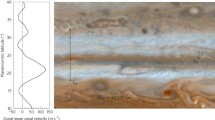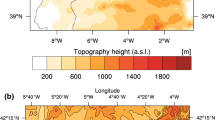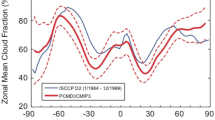Summary
The influence of turbulent friction on the propagation of cold fronts is investigated by numerical simulations using a two-dimensional mesoscale model. We compare the frictional effect with the effects of large-scale shear forcing and energy conversion at the earth's surface and discuss the synergic effect of all three mentioned processes. There is no pure superposition of these effects indicating that nonlinear interaction plays a role. In addition it is possible to show that—depending on the along-front jet—friction does not necessarily slow down the front but can also accelerate it. The direction of the along-front jet within the planetary boundary layer (PBL) is crucial for that question.
Similar content being viewed by others
References
Arritt, R. W., 1987: The effect of water surface temperature on lake-breezes and thermal internal boundary layers.Bound.-Layer Meteor.,40, 101–125.
Becker, A., 1990:Initialisierung der Querzirkulation für das Bonner-Front-Skala-Modell. Diplomarbeit, Meteorologisches Institut der Universität Bonn, 128 pp.
Becker, A., 1994: The Influence of Turbulence and Soil Properties on the Shape and Development of a Cold Front. Proceedings of the international symposium ‘The Life Cycles of Extratropical Cyclones’, Bergen, 27 June to 1 July 1994, Vol. III, 14–18.
Becker, A., 1995: Die Rolle der Turbulenz und des Bodens bei frontogenetischen Prozessen.Ber. Dtsch. Wetterdienstes,185, 163 pp.
Becker, A., Kraus, H., Ewenz, C. M., 1996: Frontal Substructures within the planetary boundary layer.Bound.-Layer Meteor.,78, 165–190.
Blackadar, A. K., 1962: The vertical distribution of wind and turbulent exchange in a neutral atmosphere.J. Geophys. Res.,67, 3095–3102.
Bond, N. A., Fleagle, R. G., 1985: Structure of a cold front over the ocean.Quart. J. Roy. Meteor. Soc.,111 739–759.
Browning, K. A., Harrold, T. W., 1970. Air motion and precipitation growth at a cold front.Quart. J. Roy Meteor. Soc.,96, 369–389.
Burk, S. D., 1984: The generation turbulent transfer and deposition of the sea-salt aerosol.J. Atmos. Sci.,41, 3040–3051.
Businger, J. A., Miyake, M., Dyer, A. J., Bradley, E. F., 1967: On the direct determination of turbulent heat flux near the ground.J. Appl. Meteor.,6, 1025–1031.
Dunst, M., Rhodin, A., 1990: On the influence of frictional effects on surface fronts.Beitr. Phys. Atmos.,63, 232–242.
Eliassen, A., 1962: On the vertical circulation in frontal zones.Geof. Publ.,24, 147–160.
Ewenz, C. M., 1993: Die Rolle der Feuchte bei frontogenetischen Prozessen.Ber. Dtsch. Wetterdienstes,187, 186pp.
Ewenz, C. M., Keuler, K., Kraus, H., Schaller, E., 1996: The diabatic modification of a developing cold front in different large-scale forcing fields.Beitr. Phys. Atmos.,69, 431–448.
Hedley, M., Yau, M. K., 1988: Radiation boundary conditions in numerical modelling.Mon. Wea. Rev.,116, 1721–1736.
Heimann, D., 1994: Frictional effects on cold fronts: geometric considerations.Beitr. Phys. Atmos.,67, 97–102.
Helfand, H. M., Labraga, J. C., 1988: Design of a nonsingular level 2.5 second-order closure model for the prediction of atmospheric turbulence.J. Atmos. Sci.,45, 113–132.
Keuler, K., Kerkmann, J., Kraus, H., Schaller, E., 1992: Orographical modification and large scale forcing of a cold front.Meteorol. Atmos. Phys.,48, 105–130.
Keyser, D., Pecnick, M. J., 1985: Diagnosis of ageostrophic circulations in a two-dimensional primitive equation model of frontogenesis.J. Atmos. Sci.,42, 1283–1305.
Kraus, H., 1995: Das neue Bild von atmosphärischen Fronten.Erdkunde,49(2), 81–105.
Marchuk, G. I., 1974: In: Arakawa, A., Mintz, Y. (eds.)Numerical Methods in Weather Prediction. New York: Academic Press, 277 pp.
Mellor, G. L., Yamada, T., 1982: Development of a turbulence closure model for geophysical fluid problems.Rev. Geophys. Space Phys.,20, 851–875.
Monin, A. S., Obukhov, M. A., 1954: Basics laws of turbulent mixing in the atmosphere near the ground.Turdy Akad. Nauk. SSSR Geofiz. Inst.,24(151), 163–187.
Paulson, C. A., 1970: The mathematical representation of wind speed and temperature profiles in the unstable atmospheric surface layer.J. Appl. Meteor.,9, 857–861.
Rhodin, A., 1995: Interaction of a cold front with a seabreeze front: numerical simulations.Tellus,47A, 403–420.
Savijärvi, H., 1992: On surface temperature and moisture prediction in atmospheric models.Beitr. Phys. Atmos.,65, 281–292.
Sawyer, J. S., 1956: The vertical circulation at meteorological fronts and its relation to frontogenesis.Proc. Roy. Soc., London,A 234, 346–362.
Shapiro, R., 1971: The use of a linear filtering as a parameterization of atmospheric diffusion.J. Atmos. Sci.,28, 523–531.
Smolarkiewicz, P. K., 1983: A simple positive definite advection scheme with small implicit diffusion.Mon. Wea. Rev.,111, 479–486.
Smolarkiewicz, P. K., 1984: A fully multidimensional positive definite advection transport algorithm with small implicit diffusion.J. Comput. Phys.,54, 325–362.
Wallace, J. M., Hobbs, P. V., 1977:Atmospheric Science: An Introductory Survey. New York: Academic Press, 467 pp.
Yamada, T., 1983: Simulations of nocturnal drainage flows by aq 2l turbulence closure model.J. Atmos. Sci.,40, 91–106.
Author information
Authors and Affiliations
Additional information
With 12 Figures
Rights and permissions
About this article
Cite this article
Becker, A., Keuler, K., Ewenz, C.M. et al. Enhanced cold front propagation due to turbulent mixing. Meteorl. Atmos. Phys. 62, 201–214 (1997). https://doi.org/10.1007/BF01029702
Received:
Revised:
Issue Date:
DOI: https://doi.org/10.1007/BF01029702




